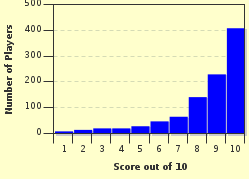Quiz Answer Key and Fun Facts
1. The world of particle physics is incredible and often very strange! What is another name given to particle physics due to the speeds used in colliding atoms?
2. Everything you can see is made up of atoms! However, the atom is so small that we couldn't possibly see just one of them. We can only see a collection of atoms, like me and you. What is an atom's volume mostly made up of?
3. The atom was at one point believed to be the most basic unit of matter. It was soon found out however that you can find smaller parts that make up an atom. What is the name given to the parts that make up protons and neutrons? A posh duck may make this noise!
4. In order for particle physicists to know their way through the atom they have to learn lists of elementary and subatomic particles. Which of the following elementary particles is commonly associated with light? Say cheese...
5. In the nucleus of an elemental atom you have one or more protons. All protons have a positive charge so it would make sense to think that protons within a nucleus repel each other, but they don't. What is the name of the force that keeps protons together in the nucleus? You may need big muscles to answer this question!
6. Particles within the nucleus known as protons and neutrons are made up of even smaller parts. These smaller parts are held together in the nucleus due to the presence of which of the following? I hope you don't get "stuck" on this question!
7. Atoms are everywhere and they are also the source of radioactivity. The three most well-known types of radiation are alpha, beta and gamma but from what language do these letters come?
8. Electrons are a very important part of the atom and are studied heavily in the science of chemistry. The movement of electrons is responsible for the wonderful colours of transition metals. On what very famous chemical table can you find the transition metals?
9. The science of physics often aims to simplify things and to unify them into one great concept. Which of the following is one example of this where the aim is to combine the two fascinating fields of general relativity and quantum mechanics? I have often wondered how long a piece of this is!
10. As physicists tried harder and harder to find more and more parts of the atom they ended up with long lists of what they considered "elementary particles". What name was given to these numerous "elementary particles" that is now known as the Standard Model? My oh my! Is that a lion, a tiger and a bear I see?
Source: Author
jonnowales
This quiz was reviewed by FunTrivia editor
NatalieW before going online.
Any errors found in FunTrivia content are routinely corrected through our feedback system.

